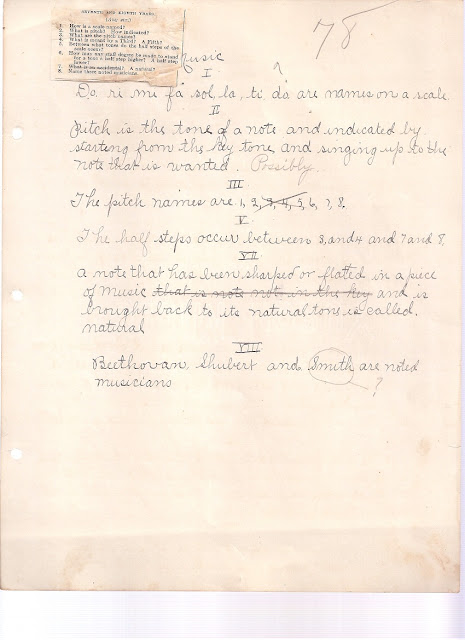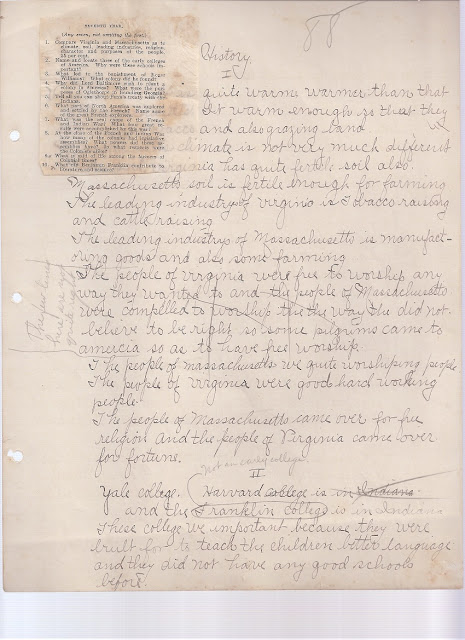Originally published on genealogyatheart.blogspot.com on 16 Oct 2015.
When I think of fall I don’t think about pumpkins and leaves like most. Instead, I think of apples. I loved apple picking as a child and I knew what would come soon after, my grandma’s apple strudel. We bobbed them, tried to bite chunks out that were dangling from the ceiling and dunked them in caramel. My neighbor, Carol, and I would twist the core while reciting the alphabet to determine the initials of who we would marry someday. Sweet or tart, there’s an apple for every one’s taste.
When my in-laws moved to a rural part of northeastern Indiana in the 1980’s, hubby and I always knew where to turn on the unmarked road – just look for the old abandoned apple orchard on the corner. The trees were gnarly and the fruit small and withered. It always looked creepy to me, even on a bright sunny summertime day. I remarked to my father-in-law that it was a shame the trees were neglected. He said that he had heard that they were once owned by Johnny Appleseed. Little did I know how right he was.
I knew Johnny Appleseed was a real person named John Chapman. With a romantic notion of him traveling the west to plant apple seedlings so that pioneers could benefit from the delicious fruit on their journey, I knew little else about him.
I passed on the story of Johnny Appleseed to my children every fall when I made my mother’s apple salad. They wanted us to plant an apple tree but in our part of Florida, that wouldn’t work.
Imagine my surprise when I discovered this newspaper clipping with my father’s papers after his death in the late 1990’s:
Like most everything my family has left me, I have no idea of the source. Grrr-no newspaper name or date. Did Dad save it because the name Leininger was mentioned or was he, too, related somehow to Johnny Appleseed? Dad and I weren’t close but there was an apple tree on my grandparent’s farm in Hobart, Indiana that I used to climb. Wouldn’t someone have told me if Johnny Appleseed was a relation?
John and George Leininger are common names in the family – I’ve got 19 John’s and 18 George’s. In addition, I’ve got combined John George and George John. I knew John Chapman never married and I had no Chapman’s in my tree so I assumed the clipping was because of seeing the Leininger name. Yet, there was some other oddities that made me wonder. My step-grandmother was from Michigan, close to Hastings, and the Leininger family first settled in Ohio, though it was not Ashtabula. My aunt’s name was Bonita and she once lived near Columbia City, Indiana. Hmmm.
It wasn’t until a distant cousin emailed me his Leininger records that I learned that John Chapman was involved with the Leininger family and that spooky old orchard did in fact once belong to him.
“According to a deed signed by President Martin Van Buren, John Chapman owned 74.04 acres in the South 1/2 of the N.W. 1/4 Sec. 3 Twp 24 Range 15. The deed was dated March 11, 1836. This land is located in the far northeast corner of Jay County, on the Wabash River. It was on this land that he planted a nursery of appletree seedlings…. John Leininger purchased through a deed, entered July 1, 1839, 128.60 acres of the S.E. fraction of Sec. 15 of the same township. This land was located about two miles south of Chapman’s land. John Leininger also purchased eight acres of land in Mercer Co., Ohio, on the other side of the State Line from his larger purchase. He built his house and buildings on the eight acres, so that he could send his children to Ohio schools, which were better at the time than Indiana’s. Please realize that this area was practically wilderness at this time.”1 My dear readers know I’ve written earlier about my family’s interesting ways to get their children into the best school districts – see blog of 20 August 2015 Education Across State Lines.
 |
| The John Chapman and John Leininger Farms – Map courtesy of Robert LeRoy Leininger in his book, Leininger Family History and Genealogy (1970) p. 7F |
So here’s how John Chapman is connected to the Leininger Family. John’s step-sister, Percis Chapman (15 Nov 1793-28 Jun 1859), married William Broom (1792-1 Mar 1848). Percis was known as John’s favorite sibling so he remained close to her, even after her marriage to William. Percis and William had 4 daughters, Mary, Lucy, Elizabeth and Harriet. Elizabeth (10 Sep 1829-2 Jun 1863) married John George Leininger (7 Feb 1826-31 Mar 1917).
 |
| Elizabeth Broom Leininger Photo courtesy of Jill on Find-a-Grave |
John George and Elizabeth had 6 children before her death. He remarried to Sarah Hough in 1864
 |
| Sarah Hough and John George Leininger Photo courtesy of Robert LeRoy Leininger |
and had 5 more children. John George is my 2nd great uncle, sibling to my 2nd great grandfather Jacob Leininger.
 |
| John George’s brothers Henry (left) and Jacob (my 2nd Great Grandfather-right) Photo courtesy of Robert LeRoy Leininger |
I’ve written about John George in a previous blog (see 26 June 2015 Planes, Trains, Automobiles & Barges, Oh My!) and how difficult it must have been for my 3rd great grandmother, Marie Gasse Leininger, to have to journey to America with young children.
 |
| Marie Margaretha Gasse Leininger Photo courtesy of Robert LeRoy Leininger |
According to family recollections, Johnny Appleseed lived with Percis and William when he came back to Indiana. William tended Johnny’s land in his absence and when Johnny died in 1845, Percis inherited Johnny’s 1200 acre nursery.2 Johnny was a wealthy man at the time of his death.
I don’t know what religion Percis and William followed but their daughter, Elizabeth, married into a Lutheran family. Johnny, however, followed the tenets of theologian Emmanuel Swedenborg. At the end of his days, Johnny was a barefoot vegetarian who preferred to treat everyone and everything with respect. Since that included Native Americans, animals and insects, Johnny was viewed as eccentric.
Here’s some things I bet you didn’t know about Johnny:
- Johnny’s dad was one of the Minute Men in Boston during the American Revolution. When Johnny’s mom and brother Nathaniel died in 1776, his dad returned home from the war. Johnny was raised by his step-mom.
- If you were a Girl Scout and sang the Johnny Appleseed blessing you really were singing Johnny’s favorite traveling song. (Ohh, the Lord is good to me, and so I thank the Lord, for giving me, the things I need, the sun, the moon and the apple seed, the Lord is good to me.)
- The trees he planted weren’t designed for eating – they were designed for drinking. Yep, Johnny was helping the settlers produce hard apple cider. No wonder they loved him! Johnny didn’t believe in grafting which is the only way you can get an edible apple. Planting apple seeds produces a fruit that may be just plain awful (but not if you’re going to use it for an alcoholic drink). Apple liquor was easier to make than corn liquor and cured quicker.
- He didn’t just sell apple trees – he also had a business selling herbs. Native Americans purchased their herbs from Johnny.
- Johnny was the “Paul Revere of the Western Frontier.” During the War of 1812 he warned settlers in Mount Vernon, Ohio that the Native Americans were planning an attack by racing 30 miles through dense forest. His actions saved the entire town.
- His pet was a wolf that he once freed from a trap.
- The west that Johnny ventured to was what we consider the midwest. He planted in Pennsylvania, Ohio and Indiana. There is some who think he went as far south as northwestern West Virginia, then known as Virginia, but that hasn’t be authenticated.
- Johnny was the first person to travel between nursery sites. He’d plant, stay a bit, then travel back to nurture a site he previously planted, move to a new site to plant and then move on to visit one he already planted. This enabled him to have supplies in various places and not lose a crop due to poor weather conditions.
- He’d rip out pages of his Bible to give to settlers and the remains of the last one he wore stuck in his belt was last known in 1970 to be in the possession of Waldo Dock, a descendant, in Celina, Ohio.
So the real Johnny would have fit right in the 1960’s as a hippie type that would have approved of Boone’s Farm Apple Wine with his special herb mixture.
Oh, and that newspaper article – seems that it was from the Ft. Wayne, Indiana newspaper around 1931 when Robert Harris was interested in finding descendants. So it wasn’t cut out by my dad after all. Most likely either my grandmother or grandfather clipped the article as that is where they were living at the time. Robert Harris published a book in 1946 about Johnny.
One more mystery remains – that apple tree I used to climb on the family farm. I wonder if it was one of Johnny’s. We couldn’t eat the fruit as my mom said it was “bad” and my grandparents were from the Ft. Wayne area so it just might have been one of Johnny’s. Too bad we’ll never know. The farm is now a subdivision and the apple tree was cut down in the
1 Leininger, Robert LeRoy Leininger Family History and Genealogy Two Centuries of Leiningers Manchester, IN: Self Published, 1971, Appendix F.
2 The Straight Dope: “What’s the story with Johnny Appleseed?” Straightdope.com. Retrieved. 11 Oct 2015.



















